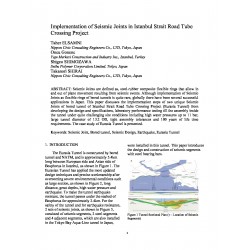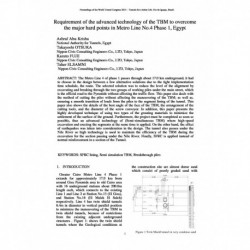No document
Search & filter
Search for a publication
Search & filter
List of products by author: T. Elsamni
-
Evaluation of applied SFRC as a steel replacement in the design stage in a part of Cairo Metro line No. 4
Abstract: Apart from development in machine technology and other cross sectional tunnel shapes, the alternative lining systems. It has carried out as well, in early sixties in the former Soviet Republic experiments were carried out with tunnel lining without any joints [1] after excavation; the soil was replaced by in site poured concrete lining. At the end of the seventies and beginning of the eighties...
0,00 € -
Evaluation of the Compressible Gasket Design and Performance for Steel Segments of Bored Tunnels
Abstract: This paper discusses a very unique research including the design and testing of the compressible type gaskets for steel segments, which has not been studied much in the field of the TBM tunneling. Over the course of developing the design of segments of steel rings or flexible rings of the bored tunnels for Eurasia Tunnel, it was discovered that gaskets do not have sufficient space to expand...
0,00 € -
Experimental study to accurate the gasket factor for segmental linings
Abstract: Elastomeric (rubber) gasket is generally used as a water tightening material for segmental linings in shield tunnels. Maximum allowable water pressure of the gasket can be calculated using the principle equation. The gasket factor depends on the profile of the gasket, the dimension of the groove on the segment, compression rate of the gasket and the value of the gap and offset (displacements...
0,00 € -
Implementation of Seismic Joints in Istanbul Strait Road Tube Crossing Project
Abstract: Seismic Joints are defined as, steel-rubber composite flexible rings that allow in and out of plane movement resulting from seismic events. Although implementation of Seismic Joints as flexible rings of bored tunnels is quite rare, globally there have been several successful applications in Japan. This paper discusses the implementation steps of two unique Seismic Joints of bored tunnel of...
0,00 € -
Requirement of the advanced technology of the TBM to overcome the major hard points in Metro Line No.4 Phase 1, Egypt
Abstract: The Metro Line 4 of phase 1 passes through about 17.0 km underground, it had to choose in the design between a few alternative solutions due to the tight implementation time schedule, the route. The selected solution was to reduce the level of the alignment by excavating and breaking through the two groups of working piles under the main street, which is the...
0,00 €





